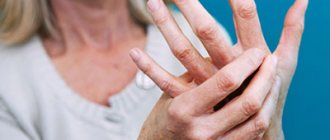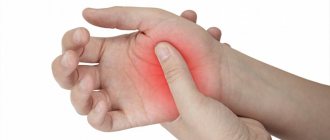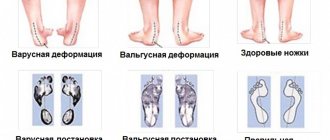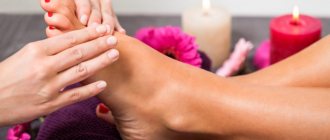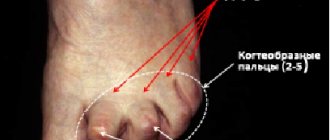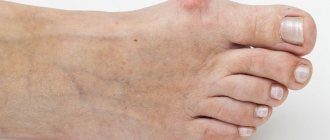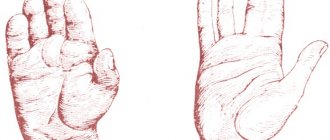Arthrosis of the big toe is a common form of arthrosis of the foot joints. This disease is popularly called “bone” and is often confused with gout, but the cause of the disease has nothing to do with excess uric acid.
The problem is a violation of metabolic and trophic processes in the tissue of hyaline cartilage. During arthrosis, structural changes in the joint lead to partial or complete immobility, which causes difficulty when trying to take even a step. On top of that, in the absence of treatment, an unaesthetic problem of a protruding growth appears and severe pain, which can accompany a person day and night.
Arthrosis of the big toe is a universal human disease, inherent in both men and women, but in the “weaker sex” it manifests itself much more often.
This selective manifestation is the result of a specific set of risk factors.
Risk factors
Despite its clear localization (joints only), arthrosis of the big toe is a multi-cause disease. The manifestation of its symptoms is preceded by a number of reasons. Among them:
- hereditary predisposition;
- domestic and professional injuries (arthrosis of the thumb is a characteristic disease of football players and ballet dancers);
- narrow and uncomfortable shoes;
- excess weight with regular loads on the legs;
- severe hypothermia;
- congenital and acquired leg deformities (flat feet, developmental pathologies);
- problems with the endocrine system, hormonal imbalances and changes (thyroid disease, diabetes, menopause, steroid use, etc.);
- long-term loads on the foot area (with low physical activity);
- age-related changes.
If you notice that you have two or more risk factors for the development of arthrosis of the big toe, you should think about undergoing preventive examinations. We have extensive experience in identifying arthrosis at the earliest stages and treating all stages.
Why does flat feet occur?
Foot deformity can be congenital or acquired. There are many reasons for this:
- fractures, injuries, ankle sprains;
- injuries of the foot, heel and tarsal bones;
- rickets, against which the bones lose density and suffer from excess load;
- weakness of muscles, ligaments and bones;
- metabolic disorders;
- excess body weight;
- incorrect, narrow, uncomfortable shoes.
The percentage of congenital flat feet is not high - only 3%. The foot is deformed due to joint dysplasia. Regardless of the source of the problem, it must be addressed, since the pathology disrupts the normal biomechanics of movement and contributes to diseases of the musculoskeletal system.
Flat feet combined with excess weight are a huge threat to your joints.
Symptoms
- Rapid fatigue of the legs;
- pain syndrome (pain can be aching or sharp);
- "weather" sensitivity;
- poor circulation in the feet (toes and feet are cold);
- joint stiffness, periodic “crunching”, especially with sudden movements;
- swollen and inflamed tissue around the “bone” of the thumb;
- deformation of the articulation area;
- nodules (Heberden) on the surface of the joint.
This list includes symptoms of different stages of the disease. Depending on the individual characteristics of the patient, they may appear earlier or later, so at the slightest sign of a problem you should consult a specialist.
Be careful! The widespread spread of the disease has given rise to many traditional methods of treating arthrosis; as a result, patients turn to doctors in the later stages.
Ointments: the basis of drug therapy
In the treatment of arthrosis of the big toe, the following groups of ointments are used:
- warming and vasodilating;
- anti-inflammatory and analgesic.
The composition of warming and vasodilating ointments may include bee venom, red pepper extract, and snake venom. Such components have a pronounced pharmacological effect. Representatives of this group:
- Apizartron;
- Gevkamen;
- Capsicam;
- Menovazin.
Preparations from the group of warming ointments cannot be used if there are open wound surfaces on the skin at the sites of intended application.
The group of anti-inflammatory and analgesic ointments includes products containing:
- diclofenac (part of Voltaren and other drugs);
- ketoprofen (Ketonal Gel, Bystrum Gel);
- indomethacin (Metindol);
- nimesulide (Nise, Nimulid);
- dimethyl sulfoxide (Dolobene).
Any of these ointments should be used only after the recommendation of a specialist. The duration of the prescribed course of therapy should not be exceeded. If external agents do not have a pronounced effect, you should consult your doctor about adjusting treatment measures. The specialist will select medications for internal use or prescribe medications in injection form. If the disease is advanced, surgical methods for treating the pathology may be required.
Stages of arthrosis of the big toe
1st stage. It may be asymptomatic at first. The feet quickly get tired, cold, and periodic “aches” and “torsion” appear in the joint of the big toe. Gradually, the general discomfort is replaced by limited mobility of the joint when walking and periodic aching pain.
Stage 2. A characteristic symptom is the appearance of callus growths on the outer part of the foot, due to forced redistribution of the load. The pain intensifies and accompanies every movement of the leg, becoming continuous over time. The joint swells and surrounding tissues become inflamed.
Stage 3. The pain becomes unbearable, accompanying the patient even at rest. A joint deformity occurs: the metatarsophalangeal joint of the big toe grows, the toe itself moves into the plane of the foot and down. The period of complete destruction of the joint and fusion of bones into a fixed joint is sometimes identified as the 4th stage of the disease.
Attention! Timely detection of the disease at the 1st stage of arthrosis allows you to stop the development of the pathological process.
Preventive actions
The metatarsophalangeal joint must withstand the heaviest load. Therefore, it is important to follow the recommendations for the prevention of degenerative-dystrophic and inflammatory diseases of the joints of the toes.
You should pay special attention to the choice of shoes. If pain occurs when wearing shoes, not even when moving, but in a calm state, you must immediately change them to orthopedic ones. Your doctor can recommend suitable models.
It is necessary to exercise; Yoga, Pilates, and swimming are especially good as preventive methods. Doctors advise regularly undergoing sanatorium-resort treatment, including swimming in mineral waters, physiotherapy, and mud therapy.
The listed preventive measures are suitable for preventing the disease and preventing the progression of an already diagnosed pathology. When diagnosed with arthrosis of the big toe joint, treatment should include preventive methods, and not just standard methods of conservative treatment. It is important to follow all medical recommendations to achieve positive dynamics of the disease.
Treatment of arthrosis
Depending on the stage, symptoms and causes, conservative or surgical methods are used to treat arthrosis of the thumb. In some cases, these areas are used comprehensively.
Conservative treatment
It is based on symptomatic treatment and supportive therapy aimed at eliminating the symptoms of arthrosis and regenerating damaged cartilage tissue (stopping destruction).
Treatment order:
- anesthesia;
- elimination of inflammation;
- improved blood circulation;
- cartilage regeneration.
Typical techniques:
- Drug treatment involves the balanced use of injectable and oral drugs, as well as local agents to achieve the main therapeutic goals: pain relief (analgesic group - analgin, spasmalgon, etc.), relief of inflammation (non-steroidal and steroid drugs), regeneration of cartilage tissue (use of chondroprotectors and supporting substances), improving blood circulation.
- Manual therapy and exercise therapy to restore the anatomically correct position of the joint elements and prevent subsequent deformation.
- Physiotherapy methods are aimed at treating arthrosis of the thumb using UHF, laser and magnetic therapy, electrophoresis, etc. The methods actively restore blood circulation, trigger the processes of regeneration of cartilage tissue and gradually relieve pain.
- Use of orthopedic devices (insoles - arch supports, special shoes, etc.).
In parallel with a set of conservative techniques, work is being done to address the causes of arthrosis (excess weight is eliminated, orthopedic shoes are prescribed, etc.).
Surgery
If conservative treatment methods are unable to cope with the restoration of normal motor activity of the joint and the pain syndrome is not relieved, a decision is made on surgical intervention. As a rule, this situation occurs at the 3rd stage of development of arthrosis of the big toe and is accompanied by:
- complete or almost complete destruction of the cartilage tissue of the joint;
- continuous pain;
- poor sensitivity to medications.
Until recently, the basis of surgical treatment was the traditional approach using either radical techniques:
- resection arthroplasty – resection of deformed areas of the joint;
- arthrodesis – treatment of pain syndrome by immobilization of the joint;
Other methods of surgical treatment are currently used:
- arthroscopy – joint sanitation: removal of the damaged meniscus, particles of destroyed cartilage tissue from the cavity of the joint capsule;
- cheilectomy – removal of deforming growths on the surface of the phalanges of the finger and articular capsule.
- osteotomy – shortening, corrective osteotomy of the proximal phalanx of the finger or 1st metatarsal bone, removal of deforming growths on the surface of the phalanges of the finger and articular capsule.
Radiographs of the feet: a.
arthrosis of the first metatarsophalangeal joint (MTP) degree 2, b. metatarsophalangeal joint after osteotomy of the phalanx of the big toe and the first metatarsal bone.
Such interventions are effective for arthrosis of 1-2 degrees, so in the world of restorative medicine there is a shift towards the treatment of arthrosis with endoprosthetics.
a.b.
appearance of the foot with arthrosis of the first PFJ, c.
X-ray of the foot with arthrosis of the big toe . Radiographs of the foot after arthroplasty of the big toe joint.
We have been performing endoprosthetics
of the first metatarsophalangeal joint
for 7 years (complete or partial replacement of damaged parts of the joint with endoprosthesis components).Many years of experience working with small joints allows us to perform similar tasks of any complexity with excellent and good results in the long term.
Conservative therapy
Conservative treatment allows you to eliminate the symptoms of the disease and start regenerative processes in the affected cartilage tissues. The main methods of conservative therapy are discussed in the table.
| Method | Characteristic |
| Drug therapy | Prescription of medications in forms for oral administration, topical administration, and injection. Analgesic drugs are used for pain relief: spasmalgon, analgin. To eliminate the inflammatory process, NSAIDs and steroid medications are prescribed. Chondroprotectors are also needed, supporting drugs to accelerate regeneration and restore trophism of the affected area |
| Therapeutic exercise and massage | Physical therapy exercises and massage, which are prescribed to patients with arthrosis outside the acute phase, restore the correct anatomical position of the joint and prevent the progression of deformity |
| Physiotherapeutic procedures | The following physiotherapeutic techniques are effective for arthrosis: ultra-high-frequency therapy, laser therapy, magnetic therapy, electrophoresis. All these methods are necessary to restore trophism and launch regenerative processes in cartilage tissues, gradually relieving pain |
| Application of orthopedic structures | Special orthopedic shoes, insoles, bandages, instep supports and special fixators restore the functionality of the affected joints |
Dr. Sperling will talk about the treatment of arthrosis:
In addition to the listed methods, other methods are also needed to eliminate the factors that provoke pathology: excess body weight, treatment of endocrine pathologies, control of the level of load on the feet.
Diagnostics
Proper treatment of arthrosis of the foot or heel requires a medical examination. During the examination, the doctor pays attention to the deformation of the foot, specific changes in the big toe and the degree of limited movement in the joints. It is important to exclude other diseases (gout, ochronosis, neurogenic arthropathy, grade 2 flatfoot, etc.). For this purpose, a detailed general blood test is prescribed and sometimes diagnostic aspiration is performed. A mandatory diagnostic method is radiography of the foot. The procedure allows us to identify bone deformations, growths, marginal defects of joint surfaces, reduction of joint spaces, sclerosis of the subchondral bone, cystic formations, and allows for differential diagnosis.
